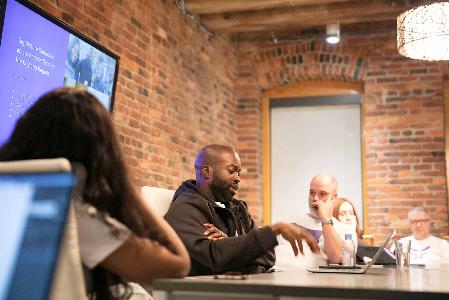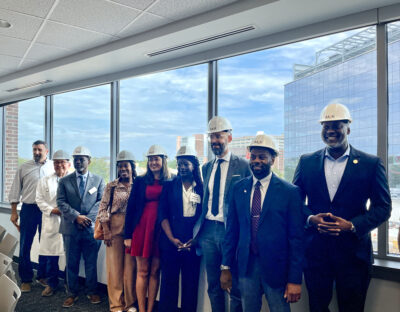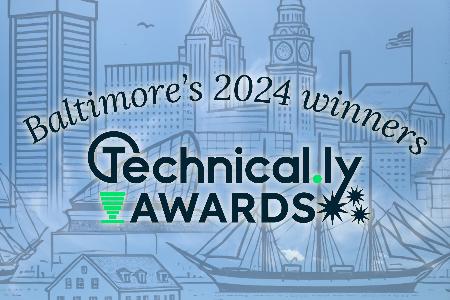Results of a study initiated more than two years ago by the Baltimore City Council to explore how city government could play a role in broadband access is nearing public release, officials with the Baltimore City Office of Information & Technology (BCIT) said.
Based off findings from the study, the city has created a broadband report with eight strategy recommendations. These include creating pilot programs of connecting community centers, churches and public housing to the city’s fiber network.
The goal is to address access in a city where, according to an Abell Foundation report released this year, 96,000 households lack access to wireline internet. While serving as city council president, now-Mayor Bernard C. “Jack” Young called for the study in 2018 as part of a package of measures to explore the city’s assets and capabilities when it comes to internet access.
The city commissioned Kensington-based CTC Technology and Energy to make recommendations. Early findings were presented by BCIT officials to a city council committee in January 2019, where officials stated they expected the report to be completed in the spring of 2019.
This year, efforts to close the digital divide have taken on additional importance in the COVID-19 pandemic, when internet access became critical for distance learning and remote work.
BCIT’s report was finished before the pandemic in March, and was delayed in release to consider the effects of COVID-19, officials said. Now it awaits approval from Baltimore’s public information office.
“Our overarching strategy is do now, do next, do later,” said Todd Carter, Baltimore City’s Chief Information Officer, who is head of BCIT, referring to the city’s approach to addressing the digital divide.
A pilot program connecting community centers to the city’s 50-mile fiber ring is in its infancy.
A fiber network is a system that uses fiber optics and results in faster internet than the typical digital service line (DSL) and cable internet, which uses copper wires and Coaxial cables. A key benefit of fiber is its download and upload speeds match.
The initial findings presented in 2018 pointed to the role fiber could play in expanding internet access to underserved areas. The cost of installing a fiber network is one of the number one reasons most ISPs don’t provide the service, so using existing assets like Baltimore the fiber ring could reduce the expense, because the only expense would be connecting to the existing infrastructure.
When it comes to connecting community centers, the internet service providers are unknown. It’s also unknown whether the services to the centers will be free or low cost, or how the community will gain access and use the internet from the community center. These are all details expected to be worked out in the pilot. We’ve seen how neighborhood anchor institutions can play a role in boosting WiFi through efforts during the pandemic from the Enoch Pratt Free Library and partnerships spearheaded by Rowdy Orb.it.
Overall, BCIT believes connecting community centers can provide residents who lack internet with a nearby place to turn for high-speed internet.
“The goal here is for us to ensure that residents have access to this type of connectivity,” said Kenya Asli, a business process strategist at BCIT who is spearheading many of the proposed broadband report initiatives. “If you don’t have it in your home, the best we can do at the moment, in terms of our priorities, is to ensure there’s a place in your neighborhood you can get access.”
Connecting public housing to fiber is a less certain plan, and the infrastructure investment is still being considered. There are also similar questions regarding ISP and price, which will likely be worked out in the pilot program with community centers.
“One distinction that we’ve made is, let’s focus on the areas that are least served,” said Carter. “Our focus on pubic housing is to get our efforts where we can really make a big bang if we do this right.”
The initial proposals stated the city was looking into municipal broadband and the idea of internet service as becoming akin to a public utility like gas or electric. That was more misnomer, as the resulting report is less about plans for the build out a network (like a new network constructed in Westminster) and more about how to extend coverage using the infrastructure in place. The report makes no claims that it’s necessary for the city to act as an internet service provider, officials said. But the proposed pilot programs suggest that there are public assets that could be used to expand internet access.
“Will we get to something like [internet as a utility]? It’s too early to tell,” said Carter. He did, however, acknowledge that the pandemic exacerbated the need. That’s why the strategies that they’ll present are focusing on access.
As for a network that is city-owed, “We’re just too in our infancy to say whether that makes sense or not,” Carter said.
Donte Kirby is a 2020-2022 corps member for Report for America, an initiative of The Groundtruth Project that pairs young journalists with local newsrooms. This position is supported by the Robert W. Deutsch Foundation.Before you go...
Please consider supporting Technical.ly to keep our independent journalism strong. Unlike most business-focused media outlets, we don’t have a paywall. Instead, we count on your personal and organizational support.
3 ways to support our work:- Contribute to the Journalism Fund. Charitable giving ensures our information remains free and accessible for residents to discover workforce programs and entrepreneurship pathways. This includes philanthropic grants and individual tax-deductible donations from readers like you.
- Use our Preferred Partners. Our directory of vetted providers offers high-quality recommendations for services our readers need, and each referral supports our journalism.
- Use our services. If you need entrepreneurs and tech leaders to buy your services, are seeking technologists to hire or want more professionals to know about your ecosystem, Technical.ly has the biggest and most engaged audience in the mid-Atlantic. We help companies tell their stories and answer big questions to meet and serve our community.
Join our growing Slack community
Join 5,000 tech professionals and entrepreneurs in our community Slack today!






